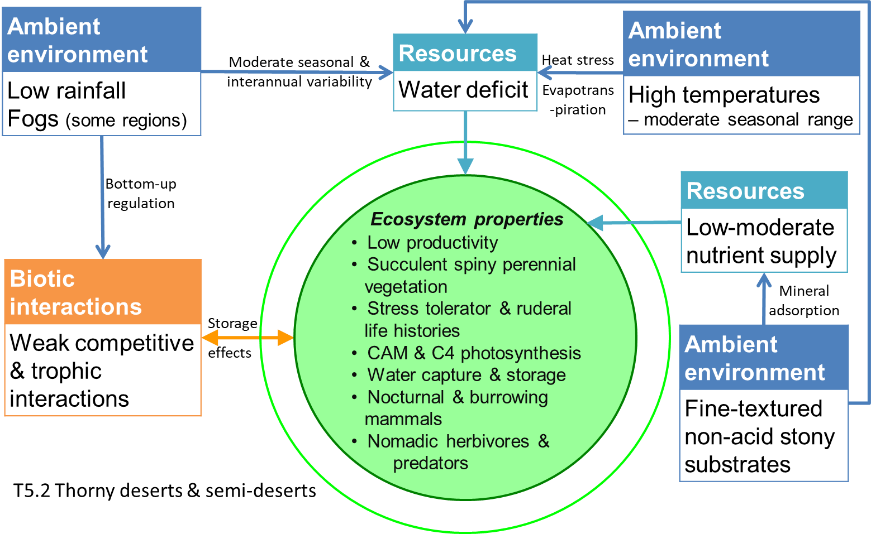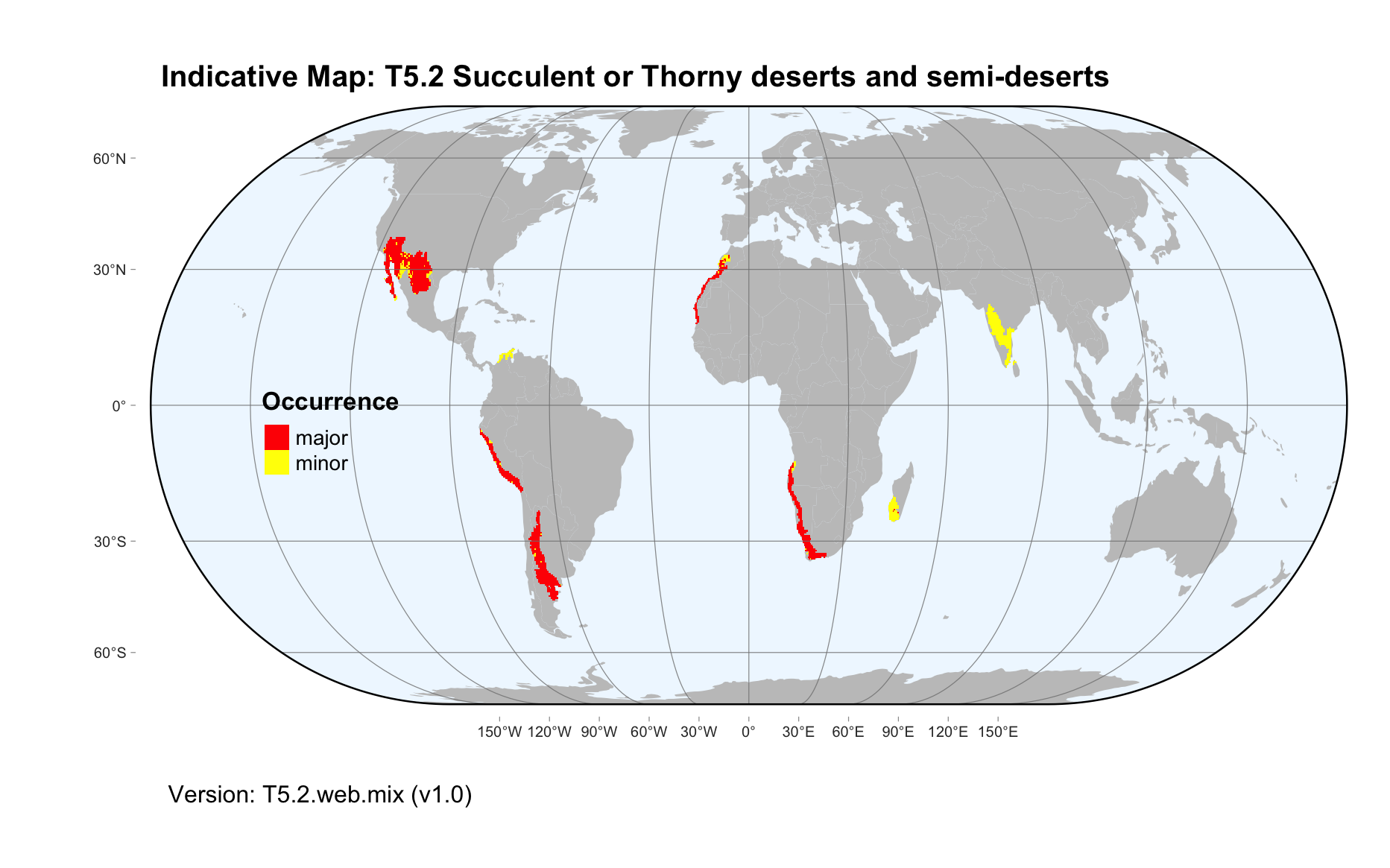Global ecosystem typology
Alternative site for the Global ecosystem typology with additional information for ecosystem profiles and indicative maps.
This site is maintained by jrfep
T5.2 Succulent or Thorny deserts and semi-deserts
Biome: T5. Deserts and semi-deserts biome
Contributors:
(texts)
Succulent or Thorny deserts and semi-deserts are restricted in their occurrence to parts of the Americas, Africa, Madagascar and south Asia. They have a sparse cover of typical cactus-like plants and other slow-growing spiny and succulent species, on stony low-nutrient soils. Many of these plants store water in their stems and have deep roots. Short-lived plant species emerge after rains from dormant organs or soil seed banks. Plants and animals tolerate extreme summer temperatures and mild winters. Nocturnal and burrowing mammals are able to avoid extreme temperatures. Diverse opportunistic invertebrates and reptiles occur, along with small numbers of large-ranging ungulates.
Key Features
Characterized by tall succulent plants, diverse annuals and geophytes, supporting diverse mammals, reptiles and invertebrates.
Overview of distribution
Subtropical latitudes of the Americas, southern Africa and southern Asia.
Profile versions
- v1.0 (2020-01-20): MG Tozer; DA Keith
- v2.0 (2020-05-31): MG Tozer; DA Keith
- v2.01 ():
- v2.1 (2022-04-06): MG Tozer; DA Keith Full profile available at official site
Main references
Selected references for this functional group:
Shmida A, Evenari M, Noy-Meir I (1986) Hot desert ecosystems: an integrated view Ecosystems of the World, Vol. 12b: Hot deserts and arid shrublands (Eds. M Evenari, I Noy Meir, DW Goodall), pp. 379-387. . Elsevier, Amsterdam
Diagrammatic assembly model

Maps
Maps are indicative of global distribution patterns are not intended to represent fine-scale patterns. The maps show areas of the world containing major (coloured red) or minor occurrences (coloured yellow) of each ecosystem functional group. See general notes on maps.
There are 2 alternative versions of the indicative map for this functional group, please compare description and sources below.
T5.2.IM.mix_v1.0
Datasets
- EarthEnv-LandCover-v1.0
- Resolve-Ecoregions-2017
Map references
Tuanmu, M.-N. and W. Jetz (2014) A global 1-km consensus land-cover product for biodiversity and ecosystem modeling Global Ecology and Biogeography 23(9):1031–1045 DOI:10.1111/geb.12182
Dinerstein E, Olson D, Joshi A, Vynne C, Burgess ND, Wikramanayake E, Hahn N, Palminteri S, Hedao P, Noss R, Hansen M, Locke H, Ellis EE, Jones B, Barber CV, Hayes R, Kormos C, Martin V, Crist E, Sechrest W, Price L, Baillie JEM, Weeden D, Suckling K, Davis C, Sizer N, Moore R, Thau D, Birch T, Potapov P, Turubanova S, Tyukavina A, de Souza N, Pintea L, Brito JC, Llewellyn Barnekow Lillesø JP, van Breugel P, Graudal L, Voge M, Al-Shammari KF, Saleem M (2017) An Ecoregion-Based Approach to Protecting Half the Terrestrial Realm, BioScience 67: 534–545. DOI:10.1093/biosci/bix014. Data-set available on-line
T5.2.web.mix_v1.0

Datasets
- EarthEnv-LandCover-v1.0
- Resolve-Ecoregions-2017
Map references
Tuanmu, M.-N. and W. Jetz (2014) A global 1-km consensus land-cover product for biodiversity and ecosystem modeling Global Ecology and Biogeography 23(9):1031–1045 DOI:10.1111/geb.12182
Dinerstein E, Olson D, Joshi A, Vynne C, Burgess ND, Wikramanayake E, Hahn N, Palminteri S, Hedao P, Noss R, Hansen M, Locke H, Ellis EE, Jones B, Barber CV, Hayes R, Kormos C, Martin V, Crist E, Sechrest W, Price L, Baillie JEM, Weeden D, Suckling K, Davis C, Sizer N, Moore R, Thau D, Birch T, Potapov P, Turubanova S, Tyukavina A, de Souza N, Pintea L, Brito JC, Llewellyn Barnekow Lillesø JP, van Breugel P, Graudal L, Voge M, Al-Shammari KF, Saleem M (2017) An Ecoregion-Based Approach to Protecting Half the Terrestrial Realm, BioScience 67: 534–545. DOI:10.1093/biosci/bix014. Data-set available on-line
Check: the Glossary / Profile structure / the public document